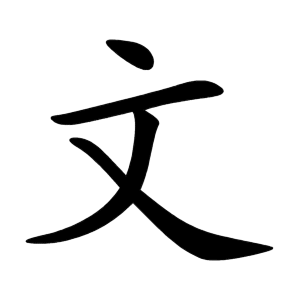文
- script, writing, letter;
Etymology
It is a pictograph originally depicting the image of a tattoo inscribed on a person’s chest. In ancient China, the earliest fundamental characters included pictographs and ideographs such as 文.
When combining 文 with 文 (either combining meanings, creating associative compounds, or combining sound and meaning to form phonetic compounds), the character 字 was created. This also expanded the original meaning of 字, which included “to give birth” or “to produce.”
As 文 came to mean “character” or “script,” a new character 紋 (meaning “pattern” or “design”) was created. Incidentally, the Korean word “무늬” (meaning “pattern”) is derived from this character.
In prehistoric China, tattoos on the body were used to distinguish social status. Later, as clothing developed, people began distinguishing social status through clothing patterns, and thus the character 文 naturally came to mean “pattern on clothing.” From there, it extended to signify any pattern or symbol in an abstract sense, eventually representing characters or writing.
This development paralleled the increasing complexity of society and the advancement of symbols, leading to words like 문자 (文字, “characters/writing”), 문화 (文化, “culture”), and 문명 (文明, “civilization”).
Usage in Korean
文 is also widely used as a family name.
In Japan, 文 is also used as a map symbol to represent a school. Korea, under Japanese colonial influence, often used this symbol on older maps to indicate schools.
Characters with 文
Words that derived from 文
- 卜大 (YK)
- ⿱ 亠 乂
